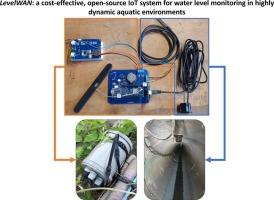LevelWAN: a cost-effective, open-source IoT system for water level monitoring in highly dynamic aquatic environments
IF 2.1
Q3 ENGINEERING, ELECTRICAL & ELECTRONIC
引用次数: 0
Abstract
The deployment of low-cost network sensors (LCNS) for environmental monitoring has become increasingly prevalent in recent years, offering a cost-effective solution for enhancing spatial sensor coverage while minimizing financial constraints. This study presents LevelWAN, a water level monitoring system specifically designed for highly dynamic aquatic environments such as rivers, ponds or lakes. LevelWAN is an open-source, robust, and cost-effective Internet of Things (IoT)-based monitoring solution incorporating an ultrasonic sensor. The electronic components were carefully selected for their affordability, reliability, and performance. The system underwent a fully autonomous, long-term (3-year) field test in a challenging and highly dynamic environment – a sewer system – to validate its robustness. Its accuracy was assessed against a high-precision professional device, demonstrating an error margin of less than 1 cm. Additionally, LevelWAN was developed with a user-friendly design to facilitate accessibility for non-experts, aligning with the needs of citizen science initiatives and educational applications.

LevelWAN:一个具有成本效益的开源物联网系统,用于高动态水生环境中的水位监测
近年来,用于环境监测的低成本网络传感器(LCNS)的部署越来越普遍,为增强空间传感器覆盖范围提供了一种经济有效的解决方案,同时最大限度地减少了资金限制。本研究介绍了LevelWAN,这是一个专门为河流、池塘或湖泊等高度动态的水生环境设计的水位监测系统。LevelWAN是一款开源、强大、经济高效的基于物联网(IoT)的监测解决方案,包含超声波传感器。电子元件经过精心挑选,价格合理,可靠性高,性能好。为了验证系统的稳健性,该系统在一个充满挑战和高度动态的环境(下水道系统)中进行了完全自主的长期(3年)现场测试。它的准确性是根据高精度专业设备进行评估的,显示误差范围小于1厘米。此外,LevelWAN的开发采用了用户友好的设计,以方便非专家访问,与公民科学倡议和教育应用的需求保持一致。
本文章由计算机程序翻译,如有差异,请以英文原文为准。
求助全文
约1分钟内获得全文
求助全文
来源期刊

HardwareX
Engineering-Industrial and Manufacturing Engineering
CiteScore
4.10
自引率
18.20%
发文量
124
审稿时长
24 weeks
期刊介绍:
HardwareX is an open access journal established to promote free and open source designing, building and customizing of scientific infrastructure (hardware). HardwareX aims to recognize researchers for the time and effort in developing scientific infrastructure while providing end-users with sufficient information to replicate and validate the advances presented. HardwareX is open to input from all scientific, technological and medical disciplines. Scientific infrastructure will be interpreted in the broadest sense. Including hardware modifications to existing infrastructure, sensors and tools that perform measurements and other functions outside of the traditional lab setting (such as wearables, air/water quality sensors, and low cost alternatives to existing tools), and the creation of wholly new tools for either standard or novel laboratory tasks. Authors are encouraged to submit hardware developments that address all aspects of science, not only the final measurement, for example, enhancements in sample preparation and handling, user safety, and quality control. The use of distributed digital manufacturing strategies (e.g. 3-D printing) is encouraged. All designs must be submitted under an open hardware license.
 求助内容:
求助内容: 应助结果提醒方式:
应助结果提醒方式:


